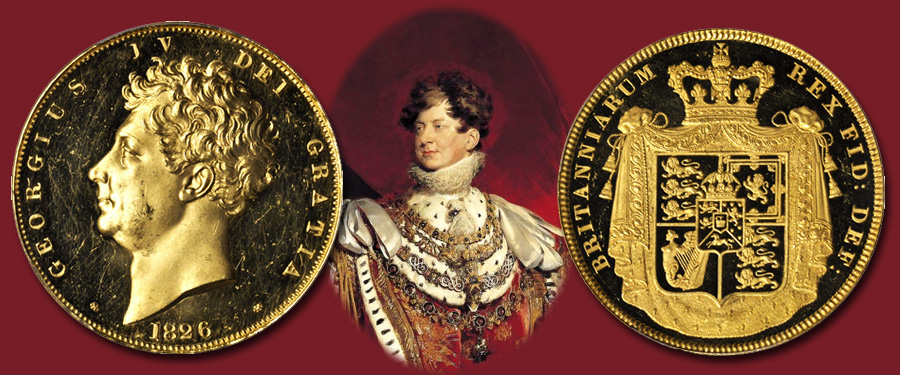
This week’s highlight from our March 25-28, 2019 Hong Kong auction, held at the Mira Hotel in conjunction with the 6th Hong Kong Coin Show (HKCS), is a 19th century masterpiece by prolific die engraver William Wyon:
Lot # 62148 – Great Britain. 5 Pounds, 1826. PCGS PROOF-62 DEEP CAMEO Gold Shield.
George IV, "The first gentleman of England," earned this title for his charm and culture. But, due to concern that his poor relationship with his parents and dissolute way of life would tarnish the prestige of the monarchy, his father, King George III, gave him an ultimatum. George IV had to either marry his cousin, Princess Caroline of Brunswick, or deal with his large financial problems on his own. Out of necessity he relented and they were married at the Chapel Royal, St. James Palace on April 8, 1795. Like many arranged marriages, this was not a happy one filled with love. The partners were vastly unsuited to each other and the marriage was a disaster. They separated after the birth of their only child, Princess Charlotte, and remained separated for the remainder of their marriage.
George IV would take many mistresses and his debts climbed out of control, while Princess Caroline spent much of her time traveling abroad. He forbid her from attending his coronation ceremony on July 19, 1821, and requested parliament introduce the unpopular "Pains and Penalties" bill in an unsuccessful and desperate attempt to divorce her. His ministers found his behavior to be selfish, unreliable and irresponsible. During the Napoleonic wars he lacked national leadership and angered his subjects with wasteful spending. Since George IV was no role model and had little interest parliamentary matters, Prime Minister Lord Liverpool, presided over the peace settlement negotiations and handled state affairs in the aftermath of the war. As George IV’s daughter died before him in 1817, he was succeeded upon his death (June 26, 1830) by his younger brother William, the last king of Britain’s House of Hanover.
According to Alex Wilson and Mark Rasmussen, authors of English Pattern, Trial and Proof Coins in Gold these patterns were generally issued in proof sets. This is the most likely scenario and would account for their great rarity in today’s marketplace. The obverse, engraved by William Wyon, depicts a fine style bust of George IV based on Sir Francis Chantry’s model. The reverse, wholly by Johann B. Merlen, depicts the highly stylized intricate crowned and mantled arms of England. This piece is a magnificent representative of the expertise employed by the Royal mint at the time, and displays frosted cameo devices and hard mirrored fields with signs of handling consistent for the grade. The opportunity to acquire such a piece does not present itself frequently and should attract much attention from advanced collectors.
We are currently taking consignments of world and ancient coins and world paper money for our June Collectors Choice Online (CCO) Auction and the August ANA World’s Fair of Money Auction in Rosemont, Illinois, a suburb of Chicago. We are also accepting consignments of Chinese and other Asian coins and currency for our August 19-22, 2019, Hong Kong Showcase Auction. If you are interested in consigning your coins and paper currency (whether a whole collection or a single rarity) contact one of our consignment directors.





